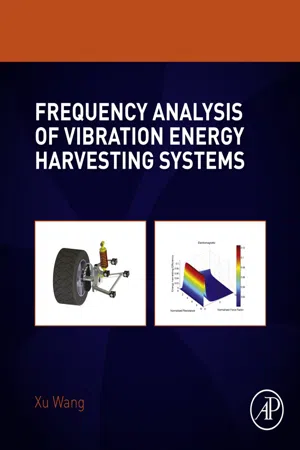
- 326 pages
- English
- ePUB (mobile friendly)
- Available on iOS & Android
Frequency Analysis of Vibration Energy Harvesting Systems
About This Book
Frequency Analysis of Vibration Energy Harvesting Systems aims to present unique frequency response methods for analyzing and improving vibration energy harvesting systems.
Vibration energy is usually converted into heat energy, which is transferred to and wasted in the environment. If this vibration energy can be converted into useful electric energy, both the performance and energy efficiency of machines, vehicles, and structures will be improved, and new opportunities will open up for powering electronic devices. To make use of ambient vibration energy, an effective analysis and design method is established and developed in this book.
The book covers a wide range of frequency response analysis methods and includes details of a variety of real-life applications. MATLAB programming is introduced in the first two chapters and used in selected methods throughout the book. Using the methods studied, readers will learn how to analyze and optimize the efficiency of vibration energy systems. This book will be ideal for postgraduate students and researchers in mechanical and energy engineering.
- Covers a variety of frequency response analysis methods, including Fourier and Laplace transform, transfer function, integration and state space for piezoelectric and electromagnetic vibration energy harvesting analysis
- Provides coverage of new and traditional methods of analyzing and optimizing the power and efficiency of vibration energy harvesting systems, with MATLAB exercises provided throughout
- Demonstrates a wide range of real-life applications, such as ocean wave energy conversion, vehicle suspension vibration energy harvesting, and more
Frequently asked questions
Information
Analysis of a Single Degree of Freedom Spring-Mass-Dashpot System Using Transfer Function, Integration, State Space, and Frequency Response Methods
Abstract
Keywords
1.1. Introduction
Table of contents
- Cover image
- Title page
- Table of Contents
- Copyright
- List of Figures
- List of Tables
- About the Author
- Preface
- Acknowledgments
- Chapter 1. Analysis of a Single Degree of Freedom Spring-Mass-Dashpot System Using Transfer Function, Integration, State Space, and Frequency Response Methods
- Chapter 2. Analysis of a Single Degree of Freedom Piezoelectric Vibration Energy Harvester System Using the Transfer Function, Integration, State Space, and Frequency Response Methods
- Chapter 3. Analysis of Piezoelectric Vibration Energy Harvester System With Different Interface Circuits
- Chapter 4. Analysis of Electromagnetic Vibration Energy Harvesters With Different Interface Circuits
- Chapter 5. Similarity and Duality of Electromagnetic and Piezoelectric Vibration Energy Harvesters
- Chapter 6. A Study of a 2DOF Piezoelectric Vibration Energy Harvester and Its Application
- Chapter 7. A Study of Multiple Degree of Freedom Piezoelectric Vibration Energy Harvester
- Chapter 8. Experimental Validation of Analytical Methods
- Chapter 9. Coupling Analysis of Linear Vibration Energy Harvesting Systems
- Chapter 10. Correlation and Frequency Response Analyses of Input and Harvested Power Under White Noise, Finite Bandwidth Random and Harmonic Excitations
- Chapter 11. Ocean Wave Energy Conversion Analysis
- Chapter 12. Analysis of Multiple Degrees of Freedom Electromagnetic Vibration Energy Harvesters and Their Applications
- Index